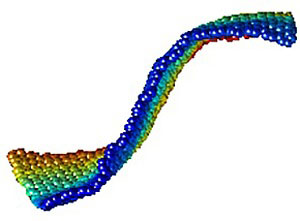| May 11, 2011 |
The effect of fluid flow on graphene
|
|
(Nanowerk News) Graphene, a single layer of carbon atoms arranged in a honeycomb lattice, initially attracted attention due to its remarkable electronic properties. It has since been realized that this material also exhibits exceptional mechanical properties. For a start, graphene is one of the hardest materials known.
|
|
There are many applications in which the mechanical properties of graphene could be exploited to achieve performance enhancements or even new functionalities, and many specific uses have been investigated. The application of graphene in a liquid environment, however, has so far received little attention. Fong Yew Leong from the A*STAR Institute of High Performance Computing has now shed some light on the effects of fluid dynamics on graphene in such applications through a combination of molecular dynamics simulations and scaling arguments ("Stability of solvated nanosheet in shear flow").
|
 |
| An atomic model of a graphene sheet flexing when immersed in bidirectional fluid flow
|
|
Leong modeled a graphene sheet, consisting of 40 by 41 atoms, immersed in a bidirectional flow of liquid argon. "As the analysis is completely scaled with respect to the size of the sheet, the actual dimensions of the graphene did not matter," he says.
|
|
According to the molecular dynamics simulations, the parameters that clearly determine the response of the graphene sheet to the flow are the initial tilt angle between the plane and the direction of flow, and the shear rate. For example, at very low tilt angles, the graphene sheet is very stable. Above a threshold tilt angle, however, a finite shear rate is required in order to rotate the sheet, and with increasing tilt angle the necessary shear rate decreases. When both parameters are sufficiently high, the sheet can actually arch (pictured) or even flex.
|
|
The results of the simulations can be explained with the help of some simple scaling arguments that consider an infinite plate subject to fluid stress. As the product of tilt angle and shear stress increases, the plate can rotate, then arch and eventually bend. Interestingly however, such simple scaling models do not predict any stability region for an infinitely thin plate. Such stability can be easily accounted for, however, by considering the solvation shell radius—the minimum distance between the sheet and solvent molecules.
|
|
The results obtained are not only relevant to the physical characteristics of graphene itself, but also provide predictions as to how a graphene sheet would behave in a strongly sheared fluid environment. "Our results are applicable to sheets of almost any size and to various flow patterns, so it is of general relevance to nanodevices involving graphene sheets," says Leong.
|

